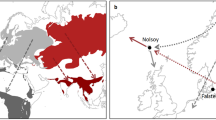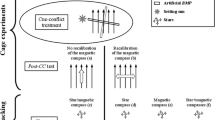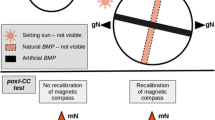Abstract
How and when migrants integrate directional information from different sources may depend not only on the bird’s internal state, including fat stores, but also on the ecological context during passage. We designed experiments to (1) examine the influence of stored fat on the decision to migrate and on the choice of migratory direction and (2) investigate how the integration of orientation cue information is tied to energetic status in relation to migration across an ecological barrier. Migratory orientation of red-eyed vireos (Vireo olivaceus) at twilight was recorded using two different techniques, orientation cage experiments and free-flight release tests, during both fall and spring migration. During fall migration, the amount of stored fat proved decisive for directional selections of the vireos. Fat birds chose directions in accordance with migration across the Gulf of Mexico. Lean birds oriented either parallel to the coast line (cage tests) or moved inland (free-flight releases). Whereas only fat birds showed significant responses to experimental deflections of the geomagnetic field, lean birds displayed a tendency to shift their activity in the expected direction, making it difficult to evaluate the prediction that use of the magnetic compass is context dependent. Fat loads also had a significant effect on the decision to migrate, i.e., fat individuals were more likely to embark on migration than were lean birds (true for both cage and release experiments). During spring migration, a majority of experimental subjects were classified as lean, following their arrival after crossing the Gulf of Mexico, and oriented in seasonally appropriate directions. The vireos also showed significant responses to experimental deflections of the geomagnetic field regardless of their energetic status. Free-flight release experiments during spring migration revealed a significant difference in mean directions between clear sky and overcast tests. The difference may indicate a compensatory response to wind drift or possibly a need for celestial cues to calibrate the magnetic compass. Finally, this is the first demonstration of magnetic compass orientation in a North American vireo.
Similar content being viewed by others
Author information
Authors and Affiliations
Additional information
Received: 15 December 1995/Accepted after revision: 24 March 1996
Rights and permissions
About this article
Cite this article
Sandberg, R., Moore, F. Migratory orientation of red-eyed vireos, Vireo olivaceus, in relation to energetic condition and ecological context. Behav Ecol Sociobiol 39, 1–10 (1996). https://doi.org/10.1007/s002650050261
Issue Date:
DOI: https://doi.org/10.1007/s002650050261




